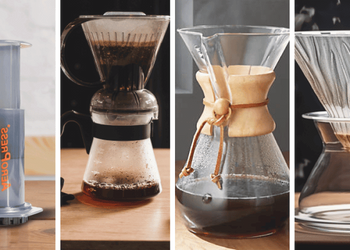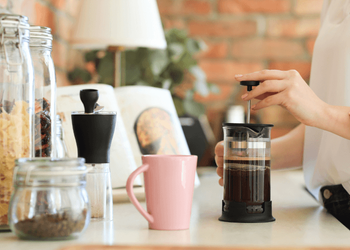
How to Use a French Press Coffee Maker? (Correctly)

French press is a manual coffee brewing tool, sometimes referred to as a cafetière or coffee plunger. It is made out of a cylindrical pot with a metal filter built in and a plunger.
Coarsely ground coffee beans are added to boiling water in a pot to brew coffee, which is then allowed to steep for a while. It is an immersion brewing method in which the liquid coffee is then separated from the grounds by depressing the plunger.
How does a French press work?
The plunger and mesh filter in a French press's mechanism separates the liquid from the coffee grounds.
The main brewing chamber of a French press is a cylindrical glass carafe. The coffee grounds in the carafe start to steep and unleash their flavors as hot water is added to them. The mesh filter at the plunger's base is intended to separate the coffee grounds from the liquid while it steeps.
The plunger is forced through the mesh filter when the specified steeping time has been reached. The mesh filter separates the liquid from the coffee grounds, keeping the grounds at the bottom of the carafe and allowing the brewed coffee to flow out and into your mug.
In order for the mesh filter to function, the liquid must be able to travel through its pores, but solid coffee grounds must be blocked. The mesh is just fine enough to catch the grinds without obstructing the flow of liquid, allowing for the best flavor extraction.
Thus, the French press mechanism offers a quick and efficient method for brewing coffee that yields a rich, robust cup of java.
How to choose a suitable French press?
When choosing a French press, consider the following factors:
1) Material
French presses are typically made of glass, stainless steel, or ceramic. Glass carafes can break easily and retain heat less effectively than stainless steel or ceramic. Stainless steel is durable and keeps your coffee hot, but it can also affect the taste of your coffee if it's not made of high-quality, food-grade stainless steel. Ceramic is a good choice if you're looking for a traditional or elegant look, but it can also be fragile.
2) Size
French presses come in various sizes, from single-serving sizes to large models that can make several cups of coffee at once. Consider how much coffee you typically make and choose a size that suits your needs.
3) Filter Quality
The quality of the filter in a French press can have a big impact on the taste and clarity of your coffee. Look for presses with multi-layer filters, such as stainless steel mesh or nylon, which provide better filtration and prevent coffee grounds from getting into your cup.
4) Insulation
If you like your coffee to stay hot, look for a French press with double-walled insulation. This will keep your coffee warm for longer.
5) Ease of use
Consider how easy the press is to use and clean. Some presses have disassemblable parts that can be easily cleaned, while others may have more complex designs that can be harder to clean.
6) Brand Reputation
Look for a brand with a good reputation for quality and customer satisfaction. Read customer reviews and do some research to find a French press that's right for you.
How to assemble a French press correctly?
Different parts of a French press and how they work:
- Pot
- Plunger
- Metal filter
- cover
are the four major components of a French press. The cylindrical pot is where the hot water and coffee grounds are kept. Typically, it is constructed from glass, stainless steel, or ceramic.
A metal filter is attached to the bottom of the plunger, which is a rod that is placed into the pot. The metal filter's purpose is to separate the brewed coffee from the grounds and keep them at the bottom of the pot.
While the coffee steeps, the lid, which rests on top of the pot, keeps it hot.
Assembling
The coffee grounds should be first added to the kettle in order to create a French press. The water should then be heated to a comfortable temperature of about 200°F (93°C) before being poured over the coffee grounds.
Gently stir the mixture, then cover the saucepan with the lid. Give the coffee 4 minutes to steep. To separate the liquid coffee from the grounds after the specified steeping time has passed, gently and steadily press the plunger down.
Tips & tricks for assembling a French press:
- Before using the plunger, make sure the metal filter is securely fastened to the bottom of the device.
- You can use a slightly greater coffee-to-water ratio to make a stronger cup of coffee.
- Use a slightly lower ratio of coffee to water if you prefer a softer cup of coffee.
- Before adding water to the pot, make sure it is at the proper temperature.
- To prevent coffee or hot water splashes, be cautious when depressing the plunger.
What materials will you need to brew coffee using a French press?
- A French Press
- Beans (whole bean or pre-ground)
- Grinder (if using whole beans)
- Water
- A kettle or container for water heating
- A spoon or stirrer
- Thermometer (Optional)
- Timer (Optional)
Pro tip
A grinder is required if using whole beans because French press coffee tastes best when it is finely ground. Before pouring water into a French press, it should be heated to about 200°F (93°C).
Before depressing the plunger, stir the coffee grounds and water using a spoon or other stirring implement. To make sure the water is at the right temperature and the coffee is steeped for the right amount of time, use a thermometer and timer.
Step-by-step guide on how to use a French press coffee maker
Step 1: Boil the water:

Begin by heating water in a different kettle or saucepan.
Step 2: Measure & grind coffee:

While the water is heating, coarsely grind your coffee beans. The amount of coffee you use will depend on the size of your French press and the intensity you want, but a good rule of thumb is 1 to 2 tablespoons of coffee per 4 ounces of water.
Step 3: Preheat the French press:

Pour a tiny amount of hot water into it, then discard the water. Fill the French press halfway with coffee grounds.
Step 4: The blooming and the brewing:
Pour a tiny quantity of water over your grinds in a circle and leave it for a few seconds. This allows your coffee to bloom and release delectable flavors and oils.
Pour boiling water over the coffee grinds in the French press, making sure to wet all of them. Allow the coffee to steep for 3 to 4 hours.

Step 5: Start the timer

As your coffee brews, covering the press will help insulate it and retain the heat within. Play the waiting game after setting a timer on The App Barista mobile app! The normal steeping duration for a coffee press is four minutes, although you can subsequently change it to your liking. The app can guide you further too.
Step 6: Plunge & decant
After some time has passed, slowly lower the plunger. If you don't press it all the way down, your coffee will continue to over-extract.

We recommend decanting your coffee before serving because the longer it sits in a container with coffee grounds, the more flavor it will extract.
Step 7: Enjoy
Hurray, your delectable cup of French Press coffee has been prepared. If you wish to filter it further, you can strain it through filter paper, but your cup is ready to refresh you.

What is the right way to serve French press coffee?
Pouring French press coffee into a warm mug or carafe is the right way to serve it. This will assist in maintaining the coffee's heat and preserving its flavor and aroma.
It is ideal to pour coffee from a French press gently and steadily, beginning in the center and moving outwards. This makes it less likely that the coffee will splash or spill.
As the coffee at the bottom of the pot would have been over-extracted and bitter, it is also crucial to avoid pouring coffee from the French press after the plunger has been squeezed down.
How to correctly clean and maintain a French press?
A few essential measures must be followed in order to properly maintain and clean a French press:
- By removing the pot, plunger, metal filter, and lid, you can disassemble the French press.
- To get rid of any coffee grounds or residue, rinse all the components in warm water.
- Use a soft brush or sponge and a light detergent to gently scrub the components if there is any sticky residue.
- To get rid of any soap residue, thoroughly rinse all the components in warm water.
- With a fresh towel or by letting them air dry, thoroughly dry every component.
- The French press should be put back together and kept dry.
Wrapping up
The French press is an easy-to-use yet adaptable coffee brewing tool that enables coffee lovers to experiment with various coffee beans, grinds, and brewing times to find the ideal cup of coffee. You may perfect the art of French press brewing and advance your coffee-making skills by using the methods and advice provided in this tutorial.
It's important to utilize freshly roasted, premium coffee beans, a coarse grind setting, clean, filtered water, the proper amount of coffee to water, consistency with the brewing time and temperature, and gentle pressure on the plunger. Additionally, always remember to routinely clean and care for your French press.
We would love to hear from our readers about their own experiences and tips for using a French press. If you have any unique or creative ways of using your French press or any tips for getting the best results, please share them in the comments section below.
Your input and feedback can help other coffee enthusiasts learn more about the French press and how to get the most out of it. So don't hesitate to share your thoughts and ideas with us!

I am a coffee aficionado based in Seattle. I have devoted my passion and expertise to perfecting the art of home coffee brewing. I became known for my exquisite pour-over and espresso creations. I source coffee beans from local roasters and explores ...



